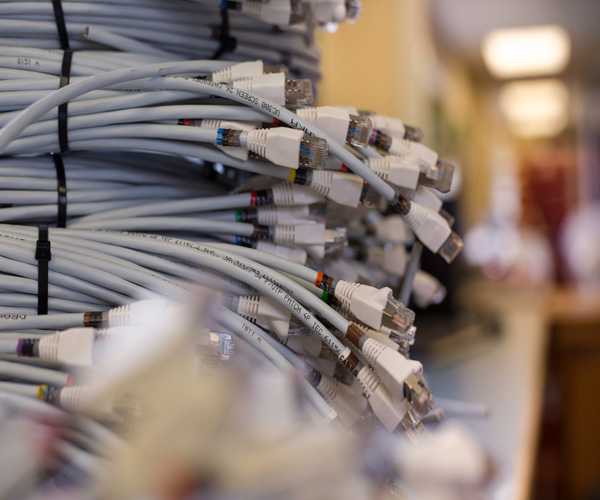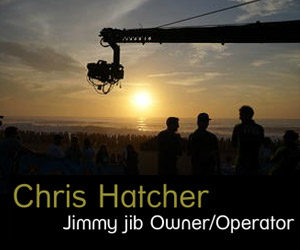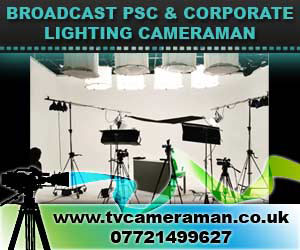Broadcast News
19/07/2017
Structured Cabling Within A Broadcast Facility

Being confronted with a complex nest of cabling, unmarked and undocumented, is the stuff of nightmares for broadcast engineers.
Structured cabling design and installation, using standard cabling that can be configured to meet changing requirements, has been adopted in broadcast as it has in ICT to avoid these problems. dB Broadcast is called upon to advise clients on the best approach to satisfy current and future needs.
Structured cabling has important benefits when installed in a new broadcast facility. It can be installed as part of the building contract rather than by broadcast specialists, and the same type of cable flood-wired throughout a building can carry different signal types for IT, phone, broadcast, etc. This all keeps costs down.
Deploying a limited number of different standard cables routed via patching frames makes installations more flexible, and can quickly accommodate additions and developments as infrastructure requirements evolve. Thus a well designed structured cabling system is an important tool to support enterprise agility and growth.
Although designing a structured cabling system increases the Broadcast SI's engineering time, it saves on SI wiring time. A well managed, unified cabling system can also reduce maintenance costs.
So what are downsides of this apparent panacea? The simple principle of structured cabling is in stark contrast with the complexity of the many options and technical standards that govern its use. Although the broadcast industry does not have published standards for cable management, it is often implemented better than in the IT world, as there are accepted practices by system integration companies such as dB Broadcast that specify documentation, cable marking at both ends, cable dressing and harnessing.
Structured wiring systems must be carefully designed as they will typically persist beyond 10 years – a long time in this era of seismic technology change. Getting the design right requires careful long-range technology trend analysis, and translation into practical requirements for the wiring system. When specifying structured wiring requirements during a recent facility build, dB Broadcast dedicated significant effort to trend analysis. This included working with both traditional broadcast vendors as well as vendors driving cutting edge datacentre design. The long-range analysis was complemented by a detailed audit of the connectivity requirements of the various subsystems within the facility.
A structured wiring system makes use of various kinds of cable. Most commonly CAT5e and CAT6 twisted pairs for shorter runs and lower bandwidth links, and fibre – both single mode and multi-mode – for longer runs and high bandwidth links. Single mode fibre can handle greater distances and can handle multiplexed signals, however it has traditionally been avoided within datacentres due to the cost of the associated optics. The development of standards such as PSM4 mean that lower cost, high bandwidth single mode optics are emerging, which is starting to make single mode infrastructure more attractive.
dB Broadcast is experiencing demand from clients for a structured cabling solution that satisfies the need for increased bandwidth. 25Gb/s works well for uncompressed live production technology and live/file based UHD workflows. Structured cabling must be carefully specified and designed to deal with this.
Where a client has commissioned flood wiring for a building, to ensure proper usage, dB is often involved in specifying and managing every patch. An essential step is the deployment of a patch management system to avoid that dreaded undocumented nest of cables that no one dares change!
Despite the advantages of the structured cabling approach, it cannot meet all broadcast cabling requirements. An SI will still need to provide local cabling.
A final point: while structured wiring can provide great flexibility to patch anything anywhere, that doesn't mean that you should. The design must be aligned with both the network and broadcast design. This is an ongoing process which often involves translating logical design into physical patching, following a coherent scheme that utilises the structured wiring infrastructure efficiently.
Customers won't thank anyone when they discover that many switch ports they need to access are harnessed at one end of a big row of swing frames, and the rack that their equipment is installed in is harnessed at the opposite end of the row, resulting in congested, unusable trunk channels and another swing frame meme on the Internet.
www.dbbroadcast.co.uk
Structured cabling design and installation, using standard cabling that can be configured to meet changing requirements, has been adopted in broadcast as it has in ICT to avoid these problems. dB Broadcast is called upon to advise clients on the best approach to satisfy current and future needs.
Structured cabling has important benefits when installed in a new broadcast facility. It can be installed as part of the building contract rather than by broadcast specialists, and the same type of cable flood-wired throughout a building can carry different signal types for IT, phone, broadcast, etc. This all keeps costs down.
Deploying a limited number of different standard cables routed via patching frames makes installations more flexible, and can quickly accommodate additions and developments as infrastructure requirements evolve. Thus a well designed structured cabling system is an important tool to support enterprise agility and growth.
Although designing a structured cabling system increases the Broadcast SI's engineering time, it saves on SI wiring time. A well managed, unified cabling system can also reduce maintenance costs.
So what are downsides of this apparent panacea? The simple principle of structured cabling is in stark contrast with the complexity of the many options and technical standards that govern its use. Although the broadcast industry does not have published standards for cable management, it is often implemented better than in the IT world, as there are accepted practices by system integration companies such as dB Broadcast that specify documentation, cable marking at both ends, cable dressing and harnessing.
Structured wiring systems must be carefully designed as they will typically persist beyond 10 years – a long time in this era of seismic technology change. Getting the design right requires careful long-range technology trend analysis, and translation into practical requirements for the wiring system. When specifying structured wiring requirements during a recent facility build, dB Broadcast dedicated significant effort to trend analysis. This included working with both traditional broadcast vendors as well as vendors driving cutting edge datacentre design. The long-range analysis was complemented by a detailed audit of the connectivity requirements of the various subsystems within the facility.
A structured wiring system makes use of various kinds of cable. Most commonly CAT5e and CAT6 twisted pairs for shorter runs and lower bandwidth links, and fibre – both single mode and multi-mode – for longer runs and high bandwidth links. Single mode fibre can handle greater distances and can handle multiplexed signals, however it has traditionally been avoided within datacentres due to the cost of the associated optics. The development of standards such as PSM4 mean that lower cost, high bandwidth single mode optics are emerging, which is starting to make single mode infrastructure more attractive.
dB Broadcast is experiencing demand from clients for a structured cabling solution that satisfies the need for increased bandwidth. 25Gb/s works well for uncompressed live production technology and live/file based UHD workflows. Structured cabling must be carefully specified and designed to deal with this.
Where a client has commissioned flood wiring for a building, to ensure proper usage, dB is often involved in specifying and managing every patch. An essential step is the deployment of a patch management system to avoid that dreaded undocumented nest of cables that no one dares change!
Despite the advantages of the structured cabling approach, it cannot meet all broadcast cabling requirements. An SI will still need to provide local cabling.
A final point: while structured wiring can provide great flexibility to patch anything anywhere, that doesn't mean that you should. The design must be aligned with both the network and broadcast design. This is an ongoing process which often involves translating logical design into physical patching, following a coherent scheme that utilises the structured wiring infrastructure efficiently.
Customers won't thank anyone when they discover that many switch ports they need to access are harnessed at one end of a big row of swing frames, and the rack that their equipment is installed in is harnessed at the opposite end of the row, resulting in congested, unusable trunk channels and another swing frame meme on the Internet.
www.dbbroadcast.co.uk
Top Related Stories
Click here for the latest broadcast news stories.
25/08/2016
TSL Systems To Expand Structured Cabling Service
TSL Systems is to announce the expansion of its fibre and structured cabling service at IBC2016, covering planning, design and installation of WLAN, c
TSL Systems To Expand Structured Cabling Service
TSL Systems is to announce the expansion of its fibre and structured cabling service at IBC2016, covering planning, design and installation of WLAN, c
04/06/2024
Videosys Broadcast Teams Up With Broadcast Rental
Videosys Broadcast has partnered with Dutch company Broadcast Rental to create a new camera control system that allows broadcasters to easily integrat
Videosys Broadcast Teams Up With Broadcast Rental
Videosys Broadcast has partnered with Dutch company Broadcast Rental to create a new camera control system that allows broadcasters to easily integrat
14/09/2022
MAVIS Broadcast Teams Up With ES Broadcast
MAVIS Broadcast has announced a partnership with ES Broadcast that will see the systems integrator offer the MAVIS Live SaaS-based production platform
MAVIS Broadcast Teams Up With ES Broadcast
MAVIS Broadcast has announced a partnership with ES Broadcast that will see the systems integrator offer the MAVIS Live SaaS-based production platform
02/09/2021
CJP Broadcast Appoints Broadcast Engineer
CJP Broadcast has appointed Rees Williams as its broadcast engineer. He joins the company after four years with event presentation company Universal L
CJP Broadcast Appoints Broadcast Engineer
CJP Broadcast has appointed Rees Williams as its broadcast engineer. He joins the company after four years with event presentation company Universal L
09/12/2019
Broadcast Solutions Reports Successful Broadcast Innovation Day 2019
Broadcast Solutions GmbH has announced a very positive balance of their Broadcast Innovation Day 2019. On 28 November 2019, the system integrator invi
Broadcast Solutions Reports Successful Broadcast Innovation Day 2019
Broadcast Solutions GmbH has announced a very positive balance of their Broadcast Innovation Day 2019. On 28 November 2019, the system integrator invi
29/11/2018
Finepoint Broadcast Announces Strong Sales In Broadcast Equipment
Finepoint Broadcast Ltd has announced strong sales both of new and pre-owned broadcast equipment throughout 2018 with accelerating demand for cameras,
Finepoint Broadcast Announces Strong Sales In Broadcast Equipment
Finepoint Broadcast Ltd has announced strong sales both of new and pre-owned broadcast equipment throughout 2018 with accelerating demand for cameras,
12/06/2018
Broadcast Solutions To Showcase Range Of Solutions At Broadcast Asia
Broadcast Solutions is to showcase a range of solutions for outside broadcasting, remote production, studio and playout facilities at Broadcast Asia i
Broadcast Solutions To Showcase Range Of Solutions At Broadcast Asia
Broadcast Solutions is to showcase a range of solutions for outside broadcasting, remote production, studio and playout facilities at Broadcast Asia i
24/11/2017
ES Broadcast Hire Increases Fujinon 4K Broadcast Lens Offering
ES Broadcast Hire has announced the further expand its considerable range of UHD live production lenses with the addition of a fleet of Fujinon's late
ES Broadcast Hire Increases Fujinon 4K Broadcast Lens Offering
ES Broadcast Hire has announced the further expand its considerable range of UHD live production lenses with the addition of a fleet of Fujinon's late
06/02/2017
Domo Broadcast Debuts New Nano HD For Broadcast
Domo Broadcast, the subdivision of Domo Tactical Communications (DTC), have announced that they will feature its new Broadcast Nano HD transmitter, PR
Domo Broadcast Debuts New Nano HD For Broadcast
Domo Broadcast, the subdivision of Domo Tactical Communications (DTC), have announced that they will feature its new Broadcast Nano HD transmitter, PR
04/07/2016
Broadcast Wireless Systems To Unveil New Codec Platform Broadcast
Wireless Systems has announced that it will unveil its plans for a new H.265/4K video codec platform at IBC 2016. Broadcast Wireless will also demonst
Broadcast Wireless Systems To Unveil New Codec Platform Broadcast
Wireless Systems has announced that it will unveil its plans for a new H.265/4K video codec platform at IBC 2016. Broadcast Wireless will also demonst
26/04/2016
Marquis Broadcast To Debut At Broadcast Asia
Marquis Broadcast has announced it will exhibit at Broadcast Asia for the first time this year. The company will demonstrate its solutions on booth 5A
Marquis Broadcast To Debut At Broadcast Asia
Marquis Broadcast has announced it will exhibit at Broadcast Asia for the first time this year. The company will demonstrate its solutions on booth 5A
04/03/2013
ATG Broadcast To Promote Its Broadcast Systems
ATG Broadcast returns to the Dubai World Trade Centre in March, promoting its all-embracing range of broadcast systems planning, design, installation,
ATG Broadcast To Promote Its Broadcast Systems
ATG Broadcast returns to the Dubai World Trade Centre in March, promoting its all-embracing range of broadcast systems planning, design, installation,
19/06/2012
dB Broadcast Showcase MERlin At Broadcast Asia 2012
dB Broadcast, the leading UK independent systems integrator and manufacturer will be showcasing the MERlin DVB-T2 receiver at Broadcast Asia 2012. MER
dB Broadcast Showcase MERlin At Broadcast Asia 2012
dB Broadcast, the leading UK independent systems integrator and manufacturer will be showcasing the MERlin DVB-T2 receiver at Broadcast Asia 2012. MER
11/05/2012
HHB Brings Broadcast Audio Expertise To Broadcast Asia 2012
HHB Communications will highlight its diverse range of professional audio products and services for broadcast sound at the Broadcast Asia 2012 show on
HHB Brings Broadcast Audio Expertise To Broadcast Asia 2012
HHB Communications will highlight its diverse range of professional audio products and services for broadcast sound at the Broadcast Asia 2012 show on
09/05/2012
Broadcast Asia 2012 Preview: ATG Broadcast
ATG Broadcast will promote its full range of systems planning, design, installation, commissioning and post-installation support services at Broadcast
Broadcast Asia 2012 Preview: ATG Broadcast
ATG Broadcast will promote its full range of systems planning, design, installation, commissioning and post-installation support services at Broadcast















